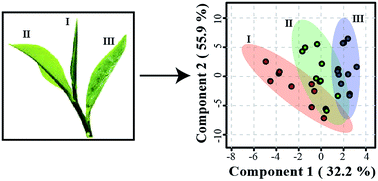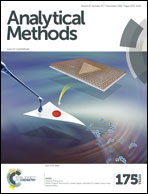A UHPLC-MS/SRM method for analysis of phenolics from Camellia sinensis leaves from Nilgiri hills†
Abstract
Nilgiri tea is grown at elevations ranging from 1000 to 2500 meters in the Western Ghats of southern India. The weather conditions provide Nilgiri teas with a characteristic briskness, exceptional fragrance and exquisite flavour. While there are many studies on the chemical composition of the Chinese, Japanese and Darjeeling variants of tea, we do not have many such reports on Nilgiri tea. In our study, twenty two phenolics were quantified from the first three leaves (Ist, IInd and IIIrd) of the tea plant from Nilgiris, by using a validated UHPLC-MS/SRM method. All analytes showed a linear relationship with regression coefficients higher than 0.996, accuracy (90–108%) and low coefficients of variation (CVs). Out of twenty two, fourteen were found to be present in quantifiable amounts in all three leaves. Quinic acid (1338 ng mg−1), gallic acid (364 ng mg−1) and epigallocatechin-3-gallate (EGCG) (302 ng mg−1) were present in higher amounts compared to the other eleven metabolites and these three compounds were also found to be higher in the Ist leaf compared to the IInd and IIIrd leaves. Next followed isoquercetin, epicatechin, isovitexin and astragalin also showing different levels in the three leaves. PLS-DA analysis indicated a clear distinction between the three leaves and six compounds showed a VIP score >1. The higher amounts of quinic acid, gallic acid and EGCG compared to those of other phenolics might be one of the reasons for the uniqueness of Nilgiri tea. This method has great application in quantifying phenolics from other plant materials with great precision.


 Please wait while we load your content...
Please wait while we load your content...